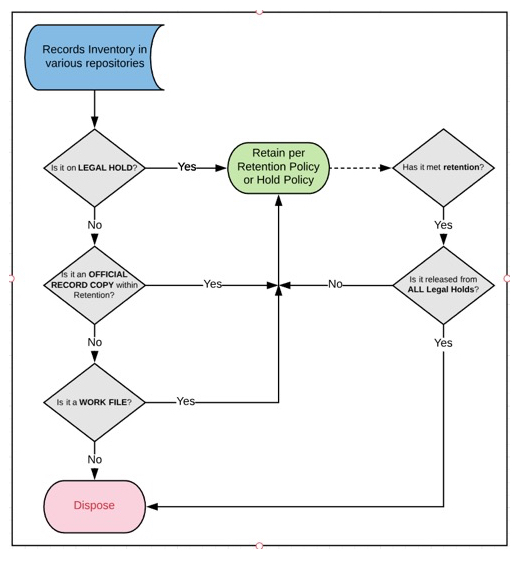
Image by: artisteer, ©2018 Getty Images
As long as records and information abound in organizations—whether in paper or digital format—so will the need to assess whether to keep or not to keep all your records. An organization must have a consistent, systematic, and repeatable process for making this decision. Otherwise, companies will just end up keeping everything forever.
Before you begin, your organization must know three important things:
- Types of records and information you hold
- Where they are retained
- Who owns and uses them

Decision Tree for Keeping Records
To find these answers, you will need to conduct an enterprise-wide records inventory for paper documents, unstructured data (primarily in local drives, network drives, email, cloud storage, such as OneDrive, or SharePoint), and structured data (systems and applications, such as databases). After this inventory, you should group all your records into three major buckets for retention consideration: legal holds, official records, and work files.
You should first consider those records under a legal hold. In case of adversarial actions, records and information must be suspended from disposal in the normal course of business and retained through a legal hold notice until such a hold is released. Subsequently, the organization can then resume normal retention and disposition.
This includes official records and work files, including copies or drafts with original markings or notes. If you have a good legal hold process, this should be the easiest group of records to identify. Many organizations make the mistake of overreaching the scope of the legal hold, resulting in retaining more records than necessary for the scope of the case.
The next consideration are your official records. These are generally the records listed in the organization's records retention schedule and should be retained for the stated retention period in the normal course of business and then discarded at the end of that period. In most cases, there should only be one set of records that is considered the official copy set. This is usually maintained by the official record owner, who may be the owner of the business function. For example, tax records are owned by the tax department; accounting records are owned by accounting; and personnel records are owned by the human resources function.
This includes official records and work files, including copies or drafts with original markings or notes. If you have a good legal hold process, this should be the easiest group of records to identify. Many organizations make the mistake of overreaching the scope of the legal hold, resulting in retaining more records than necessary for the scope of the case.
The next consideration are your official records. These are generally the records listed in the organization's records retention schedule and should be retained for the stated retention period in the normal course of business and then discarded at the end of that period. In most cases, there should only be one set of records that is considered the official copy set. This is usually maintained by the official record owner, who may be the owner of the business function. For example, tax records are owned by the tax department; accounting records are owned by accounting; and personnel records are owned by the human resources function.
In some instances, multiple owners may own the same types of records that are categorized under the same retention function. For instance, contracts may be owned by multiple functions for different types of contracts, or some organizations may centralize their contracts. In other cases, contracts may be owned by either legal or sourcing.
Official records only need to be maintained by the designated record owner, generally, the business function owner. They may be the creator of the record or the final recipient of the record.
It is important for each functional area within the organization to understand which official records they are responsible for. It is their duty to manage these records according to the records retention schedule. Therefore, it is equally important for an organization to adopt a record retention schedule that is simple, clear, understandable to the average employee, and easy to implement by the organization.
Finally, the third consideration are your work files, including messages, drafts, redundant copies, workpapers, ad hoc reports, unofficial copies, and other reference materials. These items should only be retained if they have business value for the purpose they serve. Otherwise, they should be discarded as soon as possible.
Some organizations apply a maximum retention for work files, such as two or three years. However, if there isn't a business need to retain these records, they may be discarded before the two, three, or other designated period. On the other hand, if they do have a business value that extends beyond the designated period for work files, they should never be retained longer than the retention of the official copy.
By default, all records not on a legal hold or those that are not official records can be treated as a work file and retained or discarded accordingly.
In summary, there are only three main buckets of information that need to be retained by an organization: records on a legal hold notice, official records, and work files. Each has three distinct policies for retention and disposition. As long as there is a consistent, systematic, and repeatable methodology to make this decision, an organization can have greater confidence knowing their retention and disposition process is sound and defensible.
Cindy Zuvich, CRM, is the Principal of Unigrated Global, an information governance consultancy and records management services company based in White Plains, New York. Contact Cindy at cindy.zuvich@unigrated.com.







